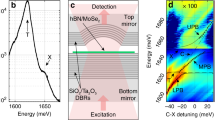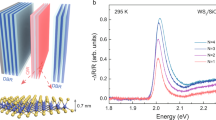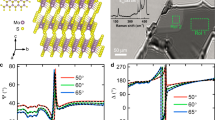Abstract
Optical parametric amplification is a second-order nonlinear process whereby an optical signal is amplified by a pump via the generation of an idler field1. This mechanism is inherently related to spontaneous parametric down-conversion, which currently constitutes the building block for entangled photon pair generation2, a process that is exploited in modern quantum technologies. Here we demonstrate single-pass optical parametric amplification at the ultimate thickness limit; using semiconducting transition metal dichalcogenides3,4, we show that amplification can be attained over propagation through a single atomic layer. Such a second-order nonlinear interaction at the two-dimensional limit bypasses phase-matching requirements5 and achieves ultrabroad amplification bandwidths. In agreement with first-principle calculations, we observe that the amplification process is independent of the in-plane polarization of signal and pump fields. By the use of AA-stacked multilayers, we present a clear pathway towards the scaling of conversion efficiency. Our results pave the way for the development of atom-sized tunable sources of radiation with potential applications in nanophotonics and quantum information technology.
This is a preview of subscription content, access via your institution
Access options
Access Nature and 54 other Nature Portfolio journals
Get Nature+, our best-value online-access subscription
$29.99 / 30 days
cancel any time
Subscribe to this journal
Receive 12 print issues and online access
$209.00 per year
only $17.42 per issue
Buy this article
- Purchase on Springer Link
- Instant access to full article PDF
Prices may be subject to local taxes which are calculated during checkout



Similar content being viewed by others
Data availability
The data that support the plots within this paper and other findings of this study are available from the corresponding author on reasonable request. Source data are provided with this paper.
References
Shen, Y. R. The Principles of Nonlinear Optics (John Wiley & Sons, 1984).
Kwiat, P. G. et al. New high-intensity source of polarisation-entangled photon pairs. Phys. Rev. Lett. 75, 4337–4341 (1995).
Chernikov, A. et al. Exciton binding energy and nonhydrogenic rydberg series in monolayer WS2. Phys. Rev. Lett. 113, 076802 (2014).
Qiu, D. Y., da Jornada, F. H. & Louie, S. G. Optical spectrum of MoS2: many-body effects and diversity of exciton states. Phys. Rev. Lett. 111, 216805 (2013).
Ciattoni, A., Marini, A., Rizza, C. & Conti, C. Phase-matching-free parametric oscillators based on two-dimensional semiconductors. Light Sci. Appl. 7, 5 (2018).
Franken, P. A., Hill, A. E., Peters, C. W. & Weinreichet, G. Generation of optical harmonics. Phys. Rev. Lett. 7, 118–119 (1961).
Stegeman, G. I., Hagan, D. J. & Torner, L. χ(2) Cascading phenomena and their applications to all-optical signal processing, mode-locking, pulse compression and solitons. Opt. Quant. Electron. 28, 1691–1740 (1996).
Giordmaine, J. A. & Miller, R. C. Tunable coherent parametric oscillation in LiNbO3 at optical frequencies. Phys. Rev. Lett. 14, 973–976 (1965).
Yariv, A. & Louisell, W. H. Theory of the optical parametric oscillator. IEEE J. Quant. Electron. 9, 418–424 (1966).
Wu, L.-A., Xiao, M. & Kimble, H. J. Squeezed states of light from an optical parametric oscillator. J. Opt. Soc. Am. B 4, 1465–1475 (1987).
Giordmaine, J. A. Mixing of light beams in crystals. Phys. Rev. Lett. 8, 19–20 (1962).
Canalias, C. & Pasiskevicius, V. Mirrorless optical parametric oscillator. Nat. Photon. 1, 459–462 (2007).
Li, Y. et al. Probing symmetry properties of few-layer MoS2 and h-BN by optical second-harmonic generation. Nano Lett. 13, 3329–3333 (2013).
Yin, X. Edge nonlinear optics on a MoS2 atomic monolayer. Science 344, 488–490 (2014).
Majumdar, A. et al. Hybrid 2D material nanophotonics: a scalable platform for low-power nonlinear and quantum optics. ACS Photon. 2, 1160–1166 (2015).
Woodward, R. I. et al. Characterization of the second- and third-order nonlinear optical susceptibilities of monolayer MoS2 using multiphoton microscopy. 2D Mater. 4, 011006 (2016).
Yu, S., Wu, X., Wang, Y., Guo, X. & Tong, L. 2D materials for optical modulation: challenges and opportunities. Adv. Mater. 29, 1606128 (2017).
Säynätjoki, A. et al. Ultra-strong nonlinear optical processes and trigonal warping in MoS2 layers. Nat. Commun. 8, 893 (2017).
Autere, A. et al. Optical harmonic generation in monolayer group-VI transition metal dichalcogenides. Phys. Rev. B 98, 115426 (2018).
Mennel, L., Paur, M. & Mueller, T. Second harmonic generation in strained transition metal dichalcogenide monolayers: MoS2, MoSe2, WS2, and WSe2. APL Photon. 4, 034404 (2019).
Liu, F. et al. Disassembling 2D van der Waals crystals into macroscopic monolayers and reassembling into artificial lattices. Science 367, 903–906 (2020).
Trovatello C. et al. Broadband optical parametric amplification by two-dimensional semiconductors. Preprint at https://arxiv.org/abs/1912.10466 (2019).
Ugeda, M. M. et al. Giant bandgap renormalization and excitonic effects in a monolayer transition metal dichalcogenide semiconductor. Nat. Mater. 13, 1091–1095 (2014).
Selig, M. et al. Excitonic linewidth and coherence lifetime in monolayer transition metal dichalcogenides. Nat. Commun. 7, 13279 (2016).
Wang, G. et al. Giant enhancement of the optical second-harmonic emission of WSe2 monolayers by laser excitation at exciton resonances. Phys. Rev. Lett. 114, 097403 (2015).
Seyler, K. L. et al. Electrical control of second-harmonic generation in a WSe2 monolayer transistor. Nat. Nanotechnol. 10, 407–411 (2015).
Bergfeld, S. & Daum, W. Second-harmonic generation in gaas: experiment versus theoretical predictions of \({\chi }_{xyz}^{(2)}\). Phys. Rev. Lett. 90, 036801 (2003).
He, J., Hummer, K. & Franchini, C. Stacking effects on the electronic and optical properties of bilayer transition metal dichalcogenides MoS2, MoSe2, WS2, and WSe2. Phys. Rev. B 89, 075409 (2014).
Zhao, M. et al. Atomically phase-matched second-harmonic generation in a 2D crystal. Light Sci. Appl. 8, e16131 (2016).
Liu, F., Ziffer, M. E., Hansen, K. R., Wang, J. & Zhu, X. Direct determination of band-gap renormalization in the photoexcited monolayer MoS2. Phys. Rev. Lett. 122, 246803 (2019).
Acknowledgements
C.T., G.C., P.J.S., J.H. and N.C. acknowledge the project SONAR, which has received funding from the European Union’s Horizon 2020 research and innovation programme under the Marie Skłodowska–Curie grant agreement (no. 734690). G.C. acknowledges support by the European Union Horizon 2020 Programme under grant agreement no. 881603 Graphene Core 3. A.M. acknowledges support from the Rita Levi Montalcini Fellowship (grant no. PGR15PCCQ5) funded by the Italian Ministry of Education, Universities and Research (MIUR). A.C. acknowledges PRIN 2017 PELM (grant no. 20177PSCKT). X.Z. acknowledges support for the Vannevar Bush Faculty Fellowship through ONR grant N00014-18-1-2080 for sample preparation, and partial support by the National Science Foundation (NSF) grant DMR-1809680 for the development of the exfoliation technique. This research was supported in part by the Department of Energy (DOE) Office of Energy Efficiency and Renewable Energy (EERE) Postdoctoral Research Award under the EERE Solar Energy Technologies Office administered by the Oak Ridge Institute for Science and Education (ORISE) for the DOE. ORISE is managed by Oak Ridge Associated Universities (ORAU) under DOE contract no. DE-SC00014664. All opinions expressed in this paper are the author’s and do not necessarily reflect the policies and views of DOE, ORAU or ORISE. P.J.S., J.H. and K.Y. acknowledge support from Columbia University’s Fu Foundation School of Engineering and Applied Science Interdisciplinary Research Seed (SIRS) Funding program. Portions of this work are supported as part of Programmable Quantum Materials, an Energy Frontier Research Center funded by the US Department of Energy (DOE), Office of Science, Basic Energy Sciences (BES), under award DE-SC0019443.
Author information
Authors and Affiliations
Contributions
C.T. designed the experiment, built the set-up, performed the measurements and wrote the manuscript. A.M. performed the theoretical calculations and wrote the manuscript. X.X. and C.L. performed the measurements. F.L. and N.C. prepared the sample. C.M. designed the experiment and performed part of the theoretical calculations. A.C. performed part of the theoretical calculations. S.D.C. helped in the design of the experiment. J.H., X.Z., P.J.S. supervised the experiments and wrote the manuscript. G.C. designed and supervised the experiment, and wrote the manuscript.
Corresponding authors
Ethics declarations
Competing interests
The authors declare no competing interest.
Additional information
Publisher’s note Springer Nature remains neutral with regard to jurisdictional claims in published maps and institutional affiliations.
Supplementary information
Supplementary Information
Supplementary Notes 1–8, Figs. 1–17 and References 1–8.
Source data
Source Data Fig. 1
Raw data and data fits from Fig. 1a–c.
Source Data Fig. 2
Raw data and data fits from Fig. 2a–c.
Source Data Fig. 3
Raw data from Fig. 3c.
Rights and permissions
About this article
Cite this article
Trovatello, C., Marini, A., Xu, X. et al. Optical parametric amplification by monolayer transition metal dichalcogenides. Nat. Photonics 15, 6–10 (2021). https://doi.org/10.1038/s41566-020-00728-0
Received:
Accepted:
Published:
Issue Date:
DOI: https://doi.org/10.1038/s41566-020-00728-0
This article is cited by
-
Wandering principal optical axes in van der Waals triclinic materials
Nature Communications (2024)
-
Confocal nonlinear optical imaging on hexagonal boron nitride nanosheets
PhotoniX (2023)
-
Strong second-harmonic generation by sublattice polarization in non-uniformly strained monolayer graphene
Nature Communications (2023)
-
Photonic van der Waals integration from 2D materials to 3D nanomembranes
Nature Reviews Materials (2023)
-
Two-dimensional semiconducting SnP2Se6 with giant second-harmonic-generation for monolithic on-chip electronic-photonic integration
Nature Communications (2023)



